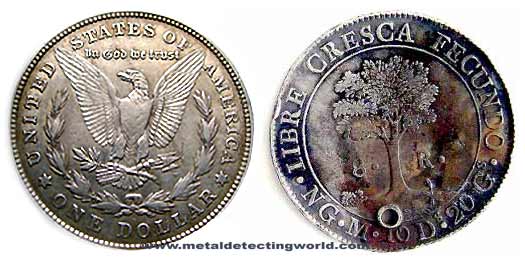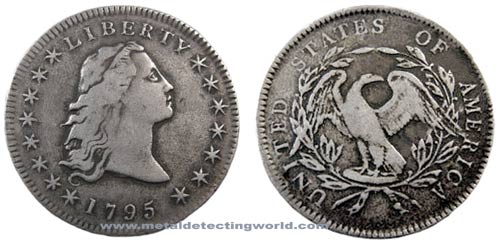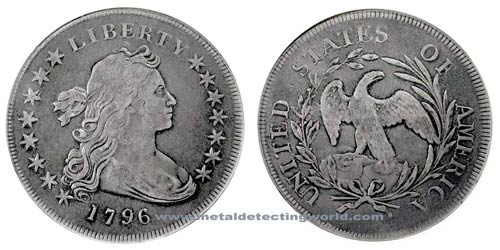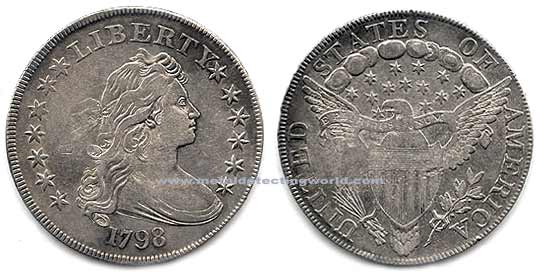US Silver Dollars (1794-1804)
Numismatic Information, Coin Values, Mintage Records and Images, page 1
This page describes US silver dollars, Flowing Hair and Draped Bust types, minted from 1794 to 1804, and includes their specifics, mintage records, key dates, average coin values (in AG-3 and EF-40 conditions) and images of a few types (not all) that were recovered at various locations in the North-East USA.
The word DOLLAR evolves from German THALER, the name given to the first large-saized European silver coin first struck in 1484.
During 16th century, such coins became so popular that many other countries struck similar pieces, giving them names derived from "thaler".
In the Netherlands the coin was called Rijksdaalder, in Denmark Rigsdaler, in Italy Tallero, in Poland Talar in France Jocandale, in Russia Jefimok. All these names are abbreviations of "Joachimsthaler".
The Spanish milled dollar, also known as the "pllar dollar" or "piece of eight," is probably one of the most, if not the most, celebrated coins in the annals of international hard money. Its extremely high silver content made it a preferred specie in bids for control over Oriental trade, and is largely responsible for a general adjustment of all world monetary system.
Popular acceptance of the Spanish milled dollar in America convinced the US Congress that the new dollar of the United States should be identical to the Spanish 8 Reales coin, except for the design. As the standard monetary unit of the United States, the word "dollar" was officially adopted by Congress on July 6, 1785.
American Morgan Dollar Next to a Piece-of-Eight (8 Reales Coin)

Authorized in 1792, the first dollar types were minted in 1794, and until 1804 all silver dollars had the value stamped on the edge: HUNDRED CENTS, ONE DOLLAR OR UNIT. After a lapse in coinage of the silver dollar from 1804 to 1835, coins were made with either plain or reeded edges, and the value was placed on the reverse side.
FLOWING HAIR TYPE 1794-1795

Some dollars of this type were weight-adjusted by inserting a small (8mm) silver plug in the center of the blank planchet before striking the coin.
Specifications:
Diameter: 39-40 mm
Weight: 26.96 grams (416 grains)
Edge: HUNDRED CENTS ONE DOLLAR OR UNIT with decorations between words
Composition: .8924 silver, .1076 copper
Quantity minted: 162,053
Mint: Philadelphia
Designer: Robert Scot
• Average coin values: AG-3 (About Good) - $450.00, EF-40 - $5,000
DRAPED BUST TYPE, Small Eagle Reverse 1795-1798

Specifications:
Diameter: 39-40 mm
Weight: 26.96 grams (416 grains)
Edge: HUNDRED CENTS ONE DOLLAR OR UNIT with decorations between words
Composition: .8924 silver, .1076 copper
Quantity minted: 450,970
Mint: Philadelphia
Designer: Robert Scot
• Average coin values: AG-3 - $400.00, EF-40 - $3,800
DRAPED BUST TYPE, Heraldic Eagle Reverse 1798-1804

Specifications:
Diameter: 39-40 mm
Weight: 26.96 grams (416 grains)
Edge: HUNDRED CENTS ONE DOLLAR OR UNIT with decorations between words
Composition: .8924 silver, .1076 copper
Quantity minted: 698,889
Mint: Philadelphia
Designer: Robert Scot
• Average coin values: G-4 - $400.00, EF-40 - $1,500
The 1804 dollar is one of the most publicized rarities in the entire series of United States coins. There are specimens known as originals (first reverse), of which eight are known, and restrikes (second reverse), of which seven are known.
Numismatists have found that the 1804 "original" dollars were struck at the mint in the 1834-35 period, for use in presentation proof sets. The edges or borders of these dollars have beaded segments and raised rim, not elongated denticles such as are found on the earlier dates. Although the mint records state that 19,570 dollars were minted in 1804, it does not mention that they were dated 1804. It was the practice in those days to use old dies as long as they were serviceable. It is probable that the 1804 total for dollars actually covered coins that were dated 1803.